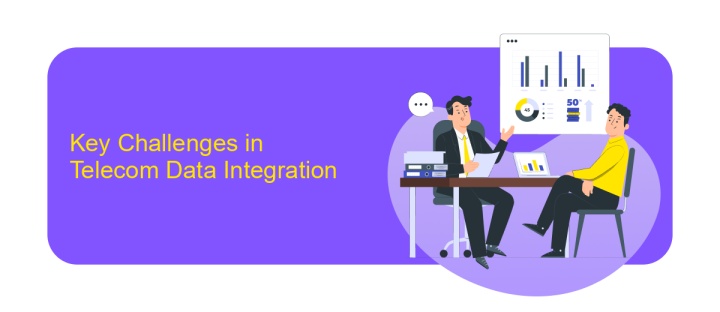Data Integration for Telecom
In today's rapidly evolving telecommunications landscape, data integration plays a crucial role in streamlining operations and enhancing customer experiences. As telecom companies grapple with vast amounts of data from diverse sources, effective integration solutions become essential. This article explores the significance of data integration in the telecom industry, highlighting key strategies and technologies that enable seamless data flow, improved decision-making, and a competitive edge in the market.
Understanding the Telecom Data Landscape
The telecom industry is characterized by vast and complex datasets that require effective integration to drive business insights and operational efficiency. Understanding the telecom data landscape involves recognizing the diverse sources and types of data that telecom companies handle. These include customer data, network performance metrics, billing information, and service usage patterns. Each dataset presents unique challenges and opportunities for integration and analysis.
- Customer Data: Includes personal information, service preferences, and interaction history.
- Network Performance Metrics: Encompasses data on signal strength, latency, and coverage.
- Billing Information: Involves transaction records, payment history, and account balances.
- Service Usage Patterns: Captures data on call durations, data consumption, and service frequency.
Integrating these diverse datasets is crucial for telecom companies to enhance customer experience, optimize network operations, and develop targeted marketing strategies. By leveraging advanced data integration techniques, telecom providers can gain a holistic view of their operations, identify trends, and make data-driven decisions. Understanding the telecom data landscape is the first step towards achieving seamless integration and unlocking the full potential of telecom data.
Key Challenges in Telecom Data Integration

Integrating data within the telecom industry presents several significant challenges. First, the sheer volume and variety of data generated by telecom networks can be overwhelming. This data comes from diverse sources such as customer interactions, network operations, and billing systems, making it difficult to consolidate into a single, cohesive system. Additionally, telecom companies often deal with legacy systems that are not easily compatible with modern data integration solutions, leading to inefficiencies and increased costs.
Another critical challenge is ensuring data quality and consistency. Disparate data sources can result in duplicated or conflicting information, which can compromise decision-making processes. Furthermore, maintaining data security and privacy is paramount, as telecom companies handle sensitive customer data. To address these challenges, services like ApiX-Drive can be instrumental. ApiX-Drive offers seamless integration solutions that connect various applications and automate data workflows, thereby enhancing efficiency and reducing the risk of errors. By leveraging such tools, telecom companies can streamline their data integration processes, ensuring that they remain competitive in an increasingly data-driven industry.
Data Integration Approaches and Technologies for Telecom

Data integration in the telecom industry is essential for managing vast amounts of data from diverse sources. Effective integration ensures seamless communication across systems, enhancing decision-making and operational efficiency. Various approaches and technologies are employed to achieve this integration, each catering to specific needs and challenges within the telecom sector.
- ETL (Extract, Transform, Load): This traditional method involves extracting data from different sources, transforming it into a suitable format, and loading it into a central repository for analysis.
- Data Virtualization: This approach allows telecom companies to access and manipulate data without moving it, providing real-time integration and reducing latency.
- API Integration: By using APIs, telecom companies can connect disparate systems and applications, facilitating real-time data exchange and improving interoperability.
- Cloud-Based Integration: Leveraging cloud platforms, telecom firms can integrate data from multiple sources, ensuring scalability and flexibility in data management.
These approaches, supported by technologies such as Apache Kafka, Talend, and Informatica, empower telecom companies to harness their data effectively. By choosing the right integration strategy, telecom firms can improve customer experience, optimize operations, and drive innovation in a rapidly evolving industry.
Benefits of Effective Data Integration in Telecom

Data integration in the telecom sector is crucial for optimizing operations and enhancing customer experiences. By unifying disparate data sources, telecom companies can gain a holistic view of their operations, leading to more informed decision-making and strategic planning.
Effective data integration allows telecom providers to streamline processes, reduce operational costs, and improve service delivery. It enables real-time data analysis, which is essential for responding swiftly to market changes and customer demands. Additionally, integrated data systems facilitate better collaboration between departments, ensuring that all teams have access to the same information.
- Improved customer insights and personalized services
- Enhanced network performance and reliability
- Increased operational efficiency and cost savings
- Better compliance with regulatory requirements
- Facilitated innovation and new service development
Ultimately, effective data integration empowers telecom companies to remain competitive in a rapidly evolving industry. By leveraging integrated data, they can anticipate customer needs, optimize network resources, and develop innovative solutions that drive growth and customer satisfaction. This strategic approach not only enhances business performance but also fosters long-term customer loyalty.
Future Trends in Telecom Data Integration
The future of telecom data integration is poised to be shaped by advancements in artificial intelligence and machine learning. These technologies will enable more efficient data processing and real-time analytics, allowing telecom companies to enhance customer experiences and optimize network performance. As 5G networks continue to expand, the volume of data generated will increase exponentially, necessitating more sophisticated integration solutions to handle the complexity and scale. This will lead to the adoption of automated data integration platforms that can seamlessly manage diverse data sources and formats.
Furthermore, the rise of cloud computing will play a pivotal role in telecom data integration. Cloud-based solutions like ApiX-Drive are set to become more prevalent, providing telecom operators with scalable and flexible integration options. These platforms simplify the integration process, enabling telecom companies to connect disparate systems and data streams effortlessly. As the industry continues to evolve, the focus will be on enhancing data security and privacy, ensuring that integrated systems comply with increasingly stringent regulatory requirements. Overall, the future of telecom data integration will be characterized by greater automation, efficiency, and security.
FAQ
What is data integration in the telecom industry?
Why is data integration important for telecom companies?
What are the common challenges in telecom data integration?
How can telecom companies ensure successful data integration?
What tools can assist in automating data integration processes in telecom?
Apix-Drive is a universal tool that will quickly streamline any workflow, freeing you from routine and possible financial losses. Try ApiX-Drive in action and see how useful it is for you personally. In the meantime, when you are setting up connections between systems, think about where you are investing your free time, because now you will have much more of it.

